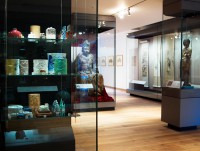Room 38 | China from AD 800 gallery
Explore key developments in the history and culture of China, from the arts and crafts of the Song Dynasty up to the present day.

During the Ming dynasty (1368-1644) China began to engage in world trade. This included exporting porcelain to Portugal and Spain in exchange for silver. As the dynasty neared its end, imperial patronage of porcelain production ceased and new markets had to be found. Japan and The Netherlands were the biggest overseas markets, but after 1700 England became the greatest importer.
From 1400 until around 1750 the technologies for clay body, glazes and decoration became increasingly refined.
 Blue-and-white kraak style bowl with banana leaf and flowers (EA1991.24)
Blue-and-white kraak style bowl with banana leaf and flowers (EA1991.24)
 Blue-and-white kendi with crayfish (EA1978.1936)
Blue-and-white kendi with crayfish (EA1978.1936)
 Cup with scholars in a landscape (EA1978.1112)
Cup with scholars in a landscape (EA1978.1112)
 Blue-and-white dish with the Portuguese arms of Pinto (EA1962.100)
Blue-and-white dish with the Portuguese arms of Pinto (EA1962.100)
 Blue-and-white vase depicting a scholar watching two women (EA1978.2036)
Blue-and-white vase depicting a scholar watching two women (EA1978.2036)
 Blue-and-white vase in double-gourd form (EA1978.938)
Blue-and-white vase in double-gourd form (EA1978.938)
 Blue-and-white dish with a figure in a landscape (EA1973.5)
Blue-and-white dish with a figure in a landscape (EA1973.5)
 Zhangzhou ware dish with pagodas and mountains (EA1978.1074)
Zhangzhou ware dish with pagodas and mountains (EA1978.1074)
 Blue-and-white tile with a landscape on one side and flowers on the other (EA1978.1174)
Blue-and-white tile with a landscape on one side and flowers on the other (EA1978.1174)
 Dish with three lion dogs playing with a ball (EAX.3509)
Dish with three lion dogs playing with a ball (EAX.3509)
 Dish with a bird on a branch (EAX.1524)
Dish with a bird on a branch (EAX.1524)
 Vase with chickens and flowers (EAX.1411)
Vase with chickens and flowers (EAX.1411)
 Dish with figures from the novel The Water Margin (EAX.3531)
Dish with figures from the novel The Water Margin (EAX.3531)
 Lantern with figures in a garden (EAX.1503)
Lantern with figures in a garden (EAX.1503)
 Beaker vase with a seated official receiving a messenger (EA1980.281)
Beaker vase with a seated official receiving a messenger (EA1980.281)
 Wucai ware vase with fish amid waves (EAX.1191)
Wucai ware vase with fish amid waves (EAX.1191)
 Blue-and-white box with figures in a garden (EAX.1414)
Blue-and-white box with figures in a garden (EAX.1414)
 Square dish with flowers (EAX.1418)
Square dish with flowers (EAX.1418)
 Spittoon with dragons (EAX.1188)
Spittoon with dragons (EAX.1188)
 Dish with a kylin, or horned creature (EA1978.980)
Dish with a kylin, or horned creature (EA1978.980)
 Tall vase with copper-red glaze (EAX.1940)
Tall vase with copper-red glaze (EAX.1940)
 Tall-necked vase with green glaze (EAX.1509)
Tall-necked vase with green glaze (EAX.1509)
 Bowl and lid with yellow glaze (EAX.1514)
Bowl and lid with yellow glaze (EAX.1514)
 Vase with 'mirror-black' glaze (EAX.1906)
Vase with 'mirror-black' glaze (EAX.1906)
Silver ingots
Spanish silver from the New World stimulated trade in silk, tea, porcelain and other commodities from China. Silver dollars circulating in China were often reshaped or countermarked, and Chinese characters are visible on some of these.
Jingdezhen egg-shaped kiln
This kiln design was developed at Jingdezhen in the late Ming period (1368-1644). The temperature range within the kiln could vary from 1000-1300 degrees celsius so that different glazes and porcelain bodies could be included in a single firing.
Porcelain saucer for the English market
By the mid-1700s most well-to-do British families had their own Chinese armorial porcelain dinner service.
This plate was commissioned in about 1760 and shows the arms of Vaughn of Brecknockshire impaling Bond.
Notice
Objects may have since been removed or replaced from a gallery. Click into an individual object record to confirm whether or not an object is currently on display. Our object location data is usually updated on a monthly basis, so contact the Jameel Study Centre if you are planning to visit the museum to see a particular Eastern Art object.
© 2013 University of Oxford - Ashmolean Museum



